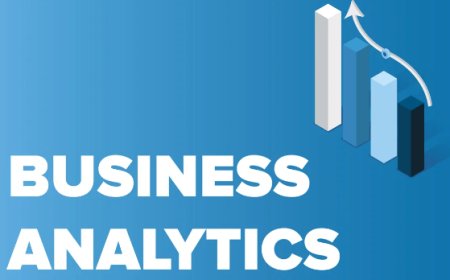7 Pillars of Business Analytics: Data-Driven Decision Making
Data, Analysis, Visualization, Modeling, Implementation, Measurement, and Optimization."

In today's fast-paced and highly competitive business landscape, the ability to harness the power of data has become paramount for sustainable success. Enter Business Analytics, the practice of using data analysis and statistical techniques to make informed and strategic business decisions. Business Analytics is revolutionizing industries by empowering organizations to optimize their processes, enhance customer experiences, and stay ahead of the curve.
Imagine a world where businesses can predict customer behavior accurately, optimize supply chain operations, and fine-tune marketing strategies with precision. That's the power of Business Analytics. In this blog, we'll delve into the 7 Pillars of Business Analytics, the foundational principles that drive effective data-driven decision making.
Data Quality and Integration
Data Quality and Integration is a fundamental aspect of Business Analytics that focuses on ensuring the accuracy, consistency, and reliability of data used for analysis. In the world of data-driven decision making, the phrase "garbage in, garbage out" holds true – if the data used in analytics is flawed, the resulting insights and decisions will be equally flawed.
-
Data Quality
Data Quality refers to the accuracy and reliability of the data collected and used for analysis. High-quality data is free from errors, inconsistencies, and duplicates. It is essential to verify that the data is coming from trustworthy sources and that it is relevant to the business's objectives. Poor data quality can lead to incorrect conclusions and misguided decision making, which can be disastrous for businesses.
Common data quality issues include missing values, incorrect data entries, outdated information, and inconsistent formats. Data cleansing and validation processes are employed to identify and rectify these issues, ensuring that the data is as accurate and reliable as possible.
-
Data Integration
In most organizations, data is collected and stored in various systems and databases. Data Integration involves bringing together data from disparate sources and consolidating it into a unified view. The goal is to create a cohesive and comprehensive dataset that can provide a holistic understanding of the business.
Data integration is essential because business data is often scattered across multiple systems, such as Customer Relationship Management (CRM) software, Enterprise Resource Planning (ERP) systems, spreadsheets, cloud applications, and more. Without integration, the data would remain siloed, making it difficult to gain meaningful insights and correlations.
-
Challenges of Data Quality and Integration
Ensuring data quality and integration can be challenging due to several factors. Firstly, different data sources may use varying data formats and standards, making it difficult to merge them seamlessly. Secondly, data from different systems may have inconsistencies and contradictions that need to be reconciled.
Another significant challenge is the sheer volume of data that organizations deal with today. Handling massive datasets requires robust data management and integration solutions. Additionally, as data sources continue to grow, maintaining data quality over time becomes an ongoing effort that demands constant vigilance.
Descriptive Analytics
Descriptive Analytics is the foundational stage of Business Analytics that focuses on understanding historical and present data to gain insights into what has happened and what is happening in a business or organization. It involves the use of various data visualization techniques, dashboards, and key performance indicators (KPIs) to summarize and present data in a meaningful and easily digestible format.
-
Historical Analysis: Descriptive Analytics mainly deals with past data, allowing organizations to assess their performance over time. It helps in understanding what has worked well and what areas need improvement.
-
Performance Monitoring: This form of analytics involves tracking key metrics and KPIs to gauge the ongoing performance of the business. It enables managers to have real-time insights into various aspects of the organization.
-
Data Visualization: Descriptive Analytics heavily relies on data visualization techniques like charts, graphs, and tables to present information visually. This makes it easier for non-technical stakeholders to grasp complex data patterns quickly.
Diagnostic Analytics
Diagnostic Analytics is a branch of data analytics that focuses on examining historical data to understand the reasons behind certain outcomes or events. It involves the use of various techniques and tools to analyze data, identify patterns, and gain insights into the factors that contributed to a particular situation or problem. The primary objective of diagnostic analytics is to answer the question "Why did it happen?" by delving into past data and exploring the root causes of specific occurrences.
Key characteristics of Diagnostic Analytics
-
Retrospective Analysis: Diagnostic analytics deals with historical data and events that have already taken place. It aims to make sense of the past and understand the factors that led to a particular outcome.
-
Root Cause Identification: The focus of diagnostic analytics is to identify the underlying causes or drivers of specific events or issues. By understanding the root causes, businesses can take corrective actions and prevent similar problems in the future.
-
Data Exploration and Visualization: To identify patterns and trends in historical data, diagnostic analytics often involves visualizing data through charts, graphs, and other visual representations. This makes it easier to interpret and communicate the findings.
Examples of Diagnostic Analytics
-
Customer Churn Analysis: Businesses may use diagnostic analytics to investigate why a significant number of customers are leaving. By analyzing historical data, they can identify common factors associated with customer churn, such as poor customer service, product issues, or pricing problems.
-
Supply Chain Delays: When a supply chain experiences delays or disruptions, diagnostic analytics can be employed to pinpoint the root causes. This could involve analyzing data related to logistics, inventory, production, and external factors like weather or geopolitical events.
-
Website Traffic Drop: If a website's traffic suddenly drops, diagnostic analytics can be used to uncover the reasons behind the decline. The analysis might include examining user behavior, content performance, technical issues, or changes in marketing efforts.
Predictive Analytics
Predictive Analytics takes a leap into the future by using historical data to make predictions about future events or trends. Employing statistical modeling and machine learning techniques, businesses can anticipate customer behavior, demand for products, and potential risks. Predictive Analytics helps in making proactive decisions to stay ahead of the competition.
Prescriptive Analytics:
Prescriptive Analytics is an advanced form of data analytics that goes beyond predicting future outcomes by providing actionable recommendations. It utilizes historical data, real-time information, and various factors to determine optimal courses of action for businesses and organizations.
By employing mathematical models, AI, machine learning, and optimization techniques, Prescriptive Analytics helps make informed decisions, optimize processes, and allocate resources efficiently across industries like finance, healthcare, supply chain management, and marketing. This powerful analytical tool enables companies to gain a competitive advantage in today's data-driven world, improve operational efficiency, foster innovation, and work towards a more sustainable future.
Real-time Analytics
-
Real-time Analytics is a data analysis approach that processes and analyzes data as it is generated or received, enabling immediate insights and actions.
-
It involves the use of advanced technologies and algorithms to handle data streams in real-time, often with minimal or no delay.
-
Real-time Analytics is essential in applications where timely decision-making is critical, such as in finance, online retail, cybersecurity, and healthcare.
-
This approach allows businesses to respond quickly to changing market conditions, customer behavior, and emerging trends.
-
Technologies like in-memory computing, stream processing, and event-driven architectures are commonly used to implement real-time analytics systems.
Data Privacy and Security
Data privacy and security are fundamental concepts that address the protection of sensitive information in the digital age. As businesses and individuals increasingly rely on digital technologies to store, transmit, and process data, ensuring the privacy and security of this data has become a critical priority. Let's explore each concept briefly:
Data Privacy
Data privacy refers to the right of individuals to control the collection, usage, and sharing of their personal information. This includes any data that can directly or indirectly identify an individual, such as names, addresses, email IDs, phone numbers, financial records, and more. Organizations that handle personal data are obligated to respect individuals' privacy rights and adhere to data protection laws and regulations.
Key aspects of data privacy include:
-
Consent: Organizations must obtain explicit consent from individuals before collecting and using their personal data for specific purposes. Consent should be informed, freely given, and easily withdrawable.
-
Data Minimization: Only the minimum amount of personal data necessary to achieve a specific purpose should be collected and retained. Unnecessary data should be deleted or anonymized.
-
Purpose Limitation: Personal data should be collected for specific, legitimate purposes disclosed to individuals. It should not be used for unrelated or undisclosed purposes.
-
Data Subject Rights: Individuals have the right to access, rectify, and delete their personal data held by organizations. They also have the right to request data portability and object to certain data processing activities.
Data Security
Data security, on the other hand, deals with protecting data from unauthorized access, use, disclosure, alteration, or destruction. It is the practice of implementing technical, organizational, and procedural measures to safeguard data from potential threats and vulnerabilities.
Key aspects of data security include:
-
Encryption: Encrypting data ensures that even if unauthorized parties gain access to it, they cannot understand the information without the decryption key.
-
Access Controls: Implementing access controls ensures that only authorized individuals within an organization can access specific data based on their roles and responsibilities.
-
Firewalls and Intrusion Detection Systems (IDS): Firewalls act as a barrier between an organization's internal network and external networks, while IDS monitors network traffic for suspicious activities and potential threats.
-
Regular Backups: Regularly backing up data ensures that in case of data loss due to cyberattacks, system failures, or human error, the data can be recovered.
The 7 Pillars of Business Analytics together create a formidable framework for data-driven decision making. By investing in high-quality data, leveraging descriptive, diagnostic, predictive, and prescriptive analytics, embracing real-time insights, and prioritizing data privacy and security, businesses can unlock the full potential of Business Analytics. In doing so, they gain a competitive edge, achieve greater efficiency, and set themselves on a path of continuous growth and success in today's data-centric world.












































